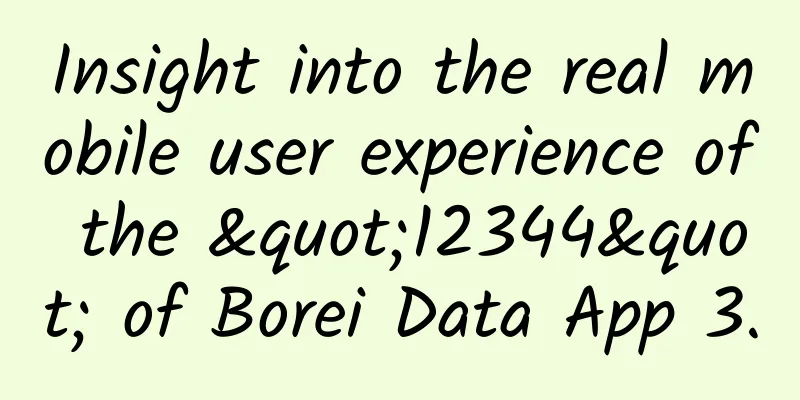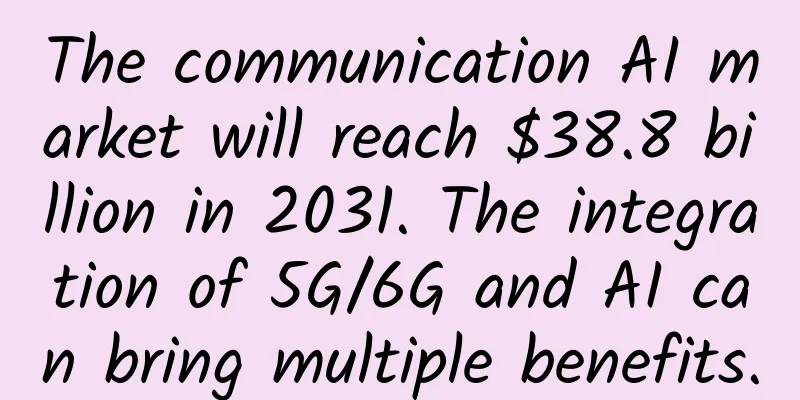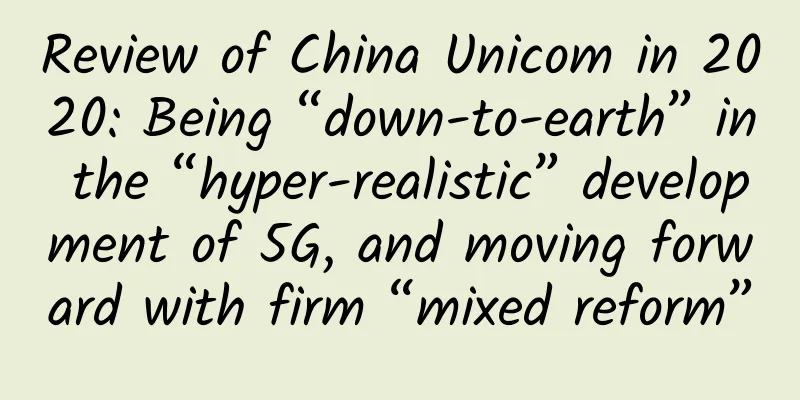Insight into the real mobile user experience of the "12344" of Borei Data App 3.0

|
【51CTO.com original article】 Nowadays, our daily life, including food, clothing, housing, transportation, and even work, cannot be separated from mobile applications. According to statistics, if the page response time is delayed by one second, user satisfaction will decrease by 16%. If the page cannot be accessed normally for more than 3 seconds, 57% of users will give up browsing. This shows that the user experience of the application is extremely important. Recently, Bonree Data released its user experience management product Bonree App 3.0. Through a nationwide cloud of real mobile devices and based on self-developed active data collection technology, it can monitor and manage the user experience, business processes, and network performance of App applications without embedding SDK, helping companies build user experience visibility. 1 question: How to monitor the user experience on the device side? According to statistics, the number of mobile users reached 930 million in 2020, the average online time per person reached 4 hours, and the number of mobile apps exceeded 3.5 million. With the rapid development of 5G and the Internet of Things, a large number of devices and terminal products have exploded, which has also brought higher complexity to the user experience monitoring of terminals. How to monitor the user experience on the device side? Sun Li, senior product director of Bonree Data, said that Bonree Data has a complete monitoring and operation and maintenance system on the server side, including monitoring of host networks, backend applications and services. However, in the process of operation and maintenance assurance, it often happens that the availability of various indicators on the operation and maintenance backend meets the SLA requirements, but the front-end user experience is not good. Therefore, Bonree Data launched Bonree APP 3.0.
Sun Li, Senior Director of Product at Borui Data 2 ways to monitor user experience Gartner defines digital experience management (DEM) as an availability and performance monitoring system that supports the optimization of the operation and maintenance experience and behavior of digital agents, people or machines when interacting with enterprise applications or services. DEM is aimed at web-based end users and mobile-based end users, and provides two monitoring methods: real user experience monitoring (RUM) and simulated user experience monitoring (STM). Real user experience monitoring is to monitor the real data experience through code injection. However, real user experience monitoring needs to be embedded on the device side, and only after real users have generated behaviors can the corresponding data be obtained to analyze the performance problems of the App. But at this time, the problem may have already occurred, so simulated user experience monitoring was born. Simulated user experience monitoring is non-intrusive, and the end user behavior is sent to the real mobile device through the application program, and the relevant business processes are executed to extract the user experience data for evaluation and optimization. Yang Xuesong, General Manager of the Customer Success Department of Borui Data, said that simulated user experience monitoring is not for all users, and is more suitable for scenarios where new functions have not yet been launched. For the core business processes of the App, corresponding scripts need to be recorded and monitored to ensure the stability of the entire application. Simulated user experience monitoring and real user experience monitoring should complement each other, and the dual modes should be used in a two-pronged approach to fully understand the user experience of terminal applications.
Yang Xuesong, General Manager of Customer Success Department of Borui Data 3 aspects of digital user experience monitoring Digital user experience is divided into three aspects of monitoring, including user experience, business process and application performance monitoring. The first is user experience, including whether users encounter crashes, freezes, business process interruptions or slow execution during use. The second is business process monitoring, which mainly monitors the user experience of core business processes to ensure the availability of the core business processes of the App. The third is application performance monitoring, including whether the App encounters freezes, high power consumption, etc. The four major advantages of App 3.0 It is understood that Bonree App 3.0 has four major advantages and features, including real mobile device cloud, non-intrusive experience perception, intelligent RPA simulation of users and experience insights and optimization insights. The real mobile device cloud, through real mobile devices and real network environments, can restore the user's access and usage scenarios to the greatest extent possible, and can locate problems in the same environment. In the past, cloud phone manufacturers used virtual simulated mobile phone data and could not truly measure the user experience. Borei Data's real mobile device cloud covers more than 200 cities and more than 15,000 real mobile terminals, covering major operators including China Telecom, China Unicom, and China Mobile. Through real network access such as 3G/4G/5G/Wifi, it can maximize the simulation of real users' experience performance in different regions and under different network conditions. In addition, the real mobile device cloud covers a variety of terminal operating systems, including iOS, Android, and Hongmeng, and supports overseas nodes. Non-intrusive experience perception, quickly obtain experience perception data through visual task configuration. The Bonree App 3.0 product has a simple usage process. You can obtain data in five steps: creating a business, uploading an application, recording a script, creating a task, and viewing data. After obtaining the APP and recording the script, the monitoring task is issued through the operation center, and the local task operation is completed through the real mobile device cloud. After collecting performance data, it is provided to the operation analyst through the data center for data query, thereby optimizing the App experience. Intelligent RPA simulates users. By integrating the automation framework and artificial intelligence technology, the program can simulate human behavior to operate the App. By using the capabilities of NLP, OCR and image recognition, the program can be made more intelligent, so as to be compatible with various situations. For example, in the past, when simulating the bank App transfer business through automation technology, it would encounter pop-up ads and other situations, and the program could not continue to execute. By adding image recognition technology, Borui Data can automatically handle unexpected situations, allowing the program to execute normally, improving the simulation accuracy and the accuracy of the program's self-flow. Experience insights and optimization. Collect data after simulating user behavior, formulate a reasonable indicator system for the App based on operation and maintenance and user experience, and use the indicator system to feedback user experience problems and propose optimization and improvement methods. In the process of creating monitoring tasks, Bonree Data benchmarks the daily usage scenarios of mobile App applications, records automated running scripts based on user usage paths, and creates monitoring tasks; in terms of experience analysis, Bonree App 3.0 can compare and analyze the digital experience of mobile App applications from dimensions such as time trends, geographical distribution, and device distribution. It builds a structured problem system based on more than 180 metrics such as network performance, UI experience, and operational experience, and further quantifies the impact of the problem. It finally uses a subjective and objective comprehensive weighting algorithm to convert it into a comprehensive digital experience evaluation; in terms of interaction analysis, it obtains the execution status of each interactive action in the user's usage path in all directions, accurately locates the bottleneck of the user's usage path, and quickly discovers business blockages; in terms of problem analysis, it builds a structured problem analysis model, which can be classified or targeted at specific problems, and goes deep from statistical distribution laws to single sessions to explore the essential causes of the problem. It is worth noting that Bonree App 3.0 first introduced the principle of information entropy, which evaluates the user experience of the page content by performing image recognition on the page content and calculating the overall information volume of the page. In addition, in order to help enterprises quickly locate problems, Bonree App 3.0 provides a session playback function, which uses the actual execution time of the session as a benchmark to reproduce the running screen of the App application and the performance behind it, linking indicator changes with interface changes, deeply analyzing the experience details of each session, and locating the root cause of the problem. Four application scenarios of App 3.0 Sun Li introduced that Bonree App 3.0 is suitable for four major application scenarios, including application experience analysis, business comparison, release verification and problem location. Scenario 1 is application experience analysis. If an enterprise needs to understand the level of its own app in the industry, it can do so through application experience comparative analysis. At the same time, it can also track experience analysis issues and continuously optimize the user experience of the application. Scenario 2 is business comparison, which focuses on the core process experience of the business. When the App is iteratively updated or the backend program is upgraded, the experience of the core business process of the application cannot be reduced. Therefore, enterprises can evaluate the availability of the application by establishing regular monitoring tasks. Scenario 3 is version verification. In today's fast-paced era, apps are frequently released, but before release, there is no real user experience access, and it is difficult to obtain application experience data, so companies will conduct grayscale verification, and review if problems are found during the verification process. With Bonree App 3.0, companies can understand the experience of each version of the application and locate and analyze problems through comparison. Scenario 4 is problem location. When a problem is found in the App, the problem can be quickly located, the problem can be continuously tracked, and the optimization benefits can be quantified. Conclusion: In May this year, after Bonree Data released a new concept of service accessibility, Bonree Data is also implementing this innovative concept. It is revealed that the release of Bonree Data Bonree App 3.0 is a software product, and Bonree Data Bonree Box 3.0 hardware products will be released in succession. The organic combination of Bonree Data Bonree APP and Bonree Box constitutes Bonree Data App 3.0, which helps enterprises achieve service accessibility and experience first. [51CTO original article, please indicate the original author and source as 51CTO.com when reprinting on partner sites] |
<<: 5G+Robots help accelerate the intelligent development of coal mines!
>>: Omdia Viewpoint: CNF is key for telecom operators to realize the promise of 5G
Recommend
EuroCloud: Los Angeles CN2 GIA/AS9929 30% off from $3.5/month, Hong Kong CN2 VPS 40% off from $3/month
Eurocloud has launched a July promotion, offering...
Last day! Tencent Cloud: 1C2G5M lightweight server 48 yuan/year, 2C4G8M three years only 198 yuan, COM domain name first year 1 yuan
Tencent Cloud's Double Eleven event has offic...
How to choose an API management platform for your business
【51CTO.com Quick Translation】As we all know, API ...
CloudPowerall: Los Angeles/Hong Kong CN2 GIA annual payment starts from $24.99
CloudPowerall is a relatively new foreign VPS ser...
[Black Friday] DediPath VPS Hosting 50% Off, 1Gbps Unlimited Dedicated Server Starting at $45/month
DediPath is a foreign VPS service provider founde...
12 principles to make data centers perform better
As American football star Tom Brady once said, &q...
Completely free! Increase your broadband speed by 500M in one second
If you are a telecom broadband user, then you mus...
Forecast of new technology trends such as 5G/NB-IoT/LTE-Cat1/LoRa/Bluetooth/WiFi
Regarding the Internet of Things, the importance ...
Network Automation Market to Surge Over the Next Decade
According to the latest forecast from Future Mark...
5G and Wi-Fi 6, the next generation of infrastructure?
Cellular and Wi-Fi networks have come together to...
A Brief Analysis of TSN Time Sensitive Network Technology
With the continuous development of industrial int...
HTTP connection management diagram
The HTTP protocol is very important to us program...
RackNerd: $9.49/year KVM-768MB/12GB/2TB/San Jose and other data centers
RackNerd released a March promotion plan, includi...
The relationship and difference between URL, URI and URN
URL Uniform Resource Locator (URL) is a reference...
The battle for 5G wide-area coverage has begun. Whose future do you think will be better?
[[410679]] Recently, the four major operators have...









